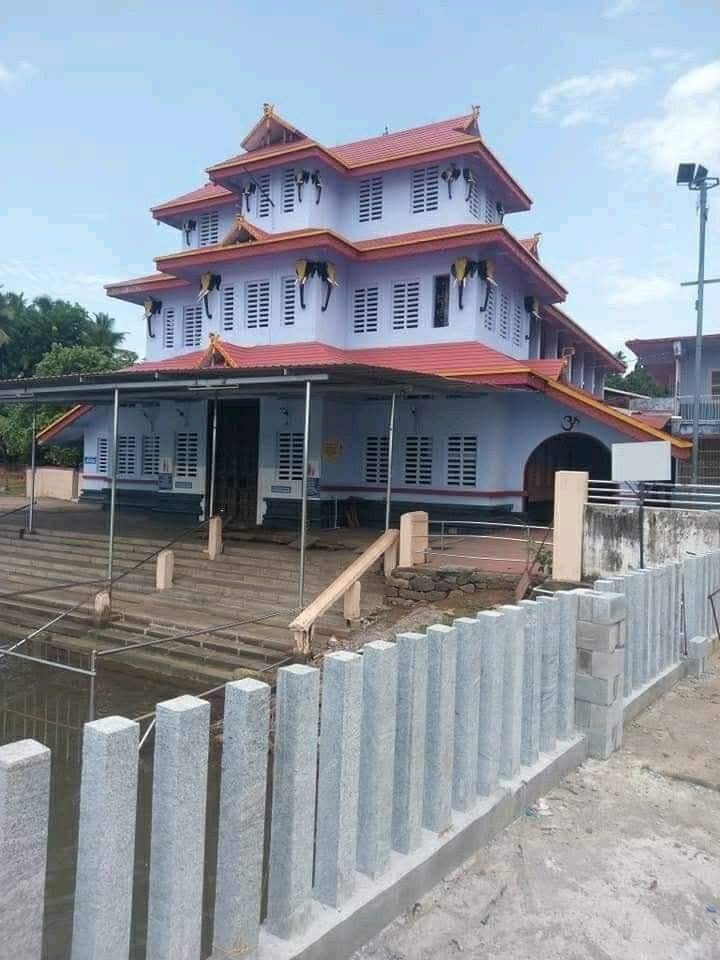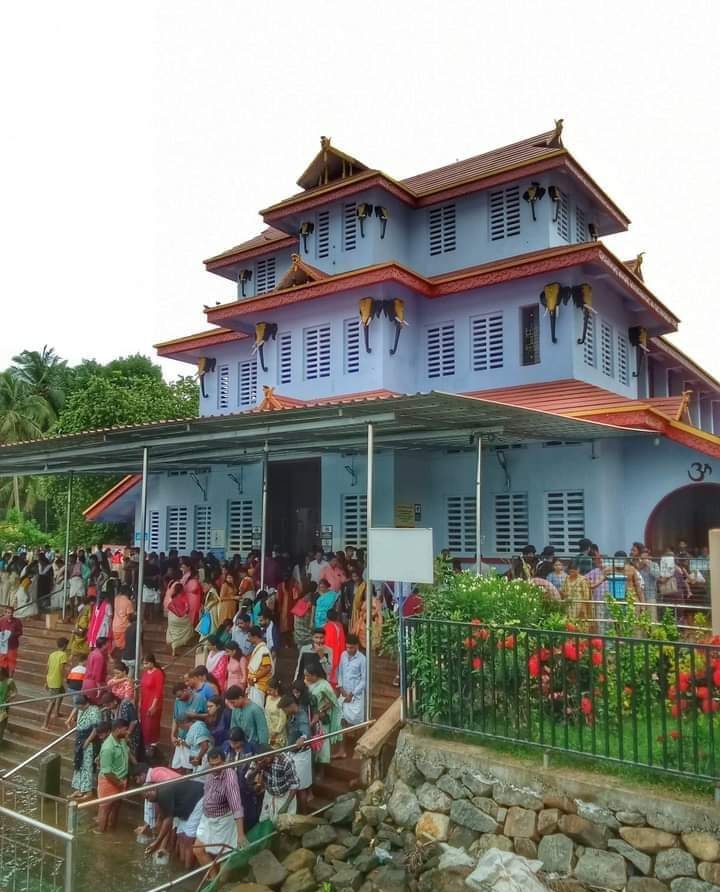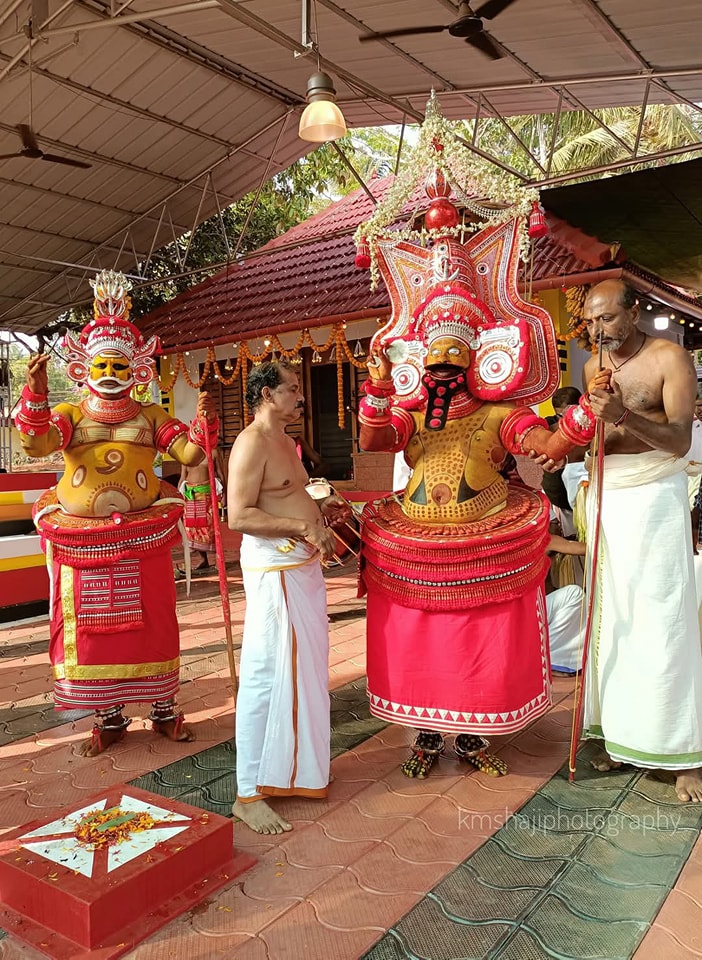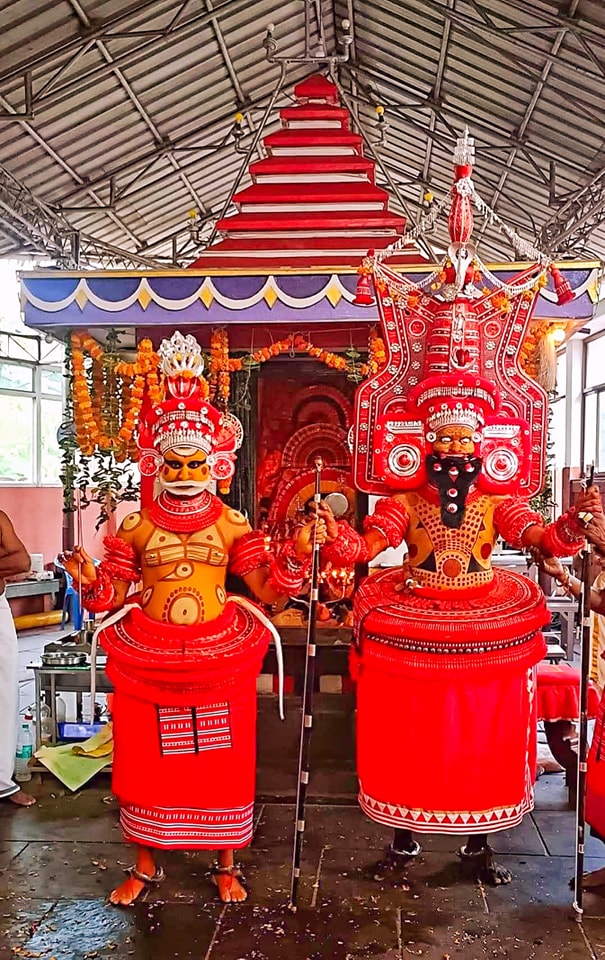Parassini Madappura Sree Muthappan Temple is a prominent temple located in Parassinikadavu, within the Anthoor municipality, on the banks of the Valapattanam River. It lies about 10 km from Taliparamba and 20 km from Kannur town in the Kannur district of Kerala, India.

The principal deity worshipped here is Sree Muthappan, whose divine presence is represented through ritualistic Theyyam performances in two distinct forms—Thiruvappan and Vellattam. As per local tradition, Sree Muthappan is considered a manifestation of Lord Shiva.
Vellattam and Thiruvappan are the two general forms of Theyyam Kettiyaadal—a sacred dance ritual performed in the temples and sacred groves (kavu) of North Malabar.
Vellattam is a simpler version of the ritual performance, characterized by minimal ornaments, decorations, and accessories. This allows the performer to express intense vaaythari (oral expressions) and perform vigorous attam (dance). In symbolic terms, Vellattam is akin to the idol of a deity without the elaborate prabhamandala (aura-like halo) surrounding it. It can be compared to a Seeveli procession where only the small idol is carried on top of an elephant without the grand adornments.
On the other hand, Thiruvappana is the elaborate and majestic version of the ritual, featuring royal regalia and a larger prabhamandalam (the symbolic halo or aura). Due to the heavy decorations and the binding nature of the attire, the movements during the performance are more restrained and measured. The uriyaadal (responses to devotees' prayers) in this form is typically brief, precise, and highly accurate.
Symbolically, Thiruvappana can be compared to a fully adorned temple idol with the prabhamandalam encircling it. In temple processions, it is akin to the Seeveli ceremony where the deity is represented by a grand Swarna-Kolam (golden frame) covering the smaller idol mounted on the elephant, radiating divine splendor.
Muthappan is regarded as a manifestation of Lord Shiva in the form of a hunter, known as the Nayattu form. The Vellattam that appears initially is considered to be Shiva himself in this minimal form. However, the Vellattam that accompanies the grand Thiruvappana later is understood to be a minimal representation of Vishnu. According to mythology, Vishnu came to assist Shiva when he began wandering with a blindfold (poykannu) and faced great difficulties in traveling and finding food.
The temple’s rituals are unique because they do not follow the traditional Satvic Brahminical style of worship seen in most Hindu temples of Kerala. Instead, the primary form of worship is the ritual performance of both forms of Muthappan through a traditional dance called Muthappan Theyyam. Offerings to Muthappan typically include fish, meat, and toddy, which reflect the non-Satvic nature of the rituals.
The main festival of the temple is the Muthappan Thiruvoppana Mahotsavam, celebrated annually over three days on the 19th, 20th, and 21st of the Malayalam month of Kumbham, corresponding to the 3rd, 4th, and 5th of March. The legend of Muthappan connects him to a tribal family, as the divine boy eventually came to be known as "Muthappan." According to the story, when he arrived at a village called Kunnathurpadi, he became friends with a tribal man named Chantan. One day, the boy saw Chantan tapping toddy from a palm tree and asked for some, but Chantan refused. As a result, he was cursed and turned into stone.
Chantan’s wife prayed sincerely and promised to offer rituals such as Oottu, Thiruvappana, and Amruthakalasam in the month of Dhanu to appease the boy. Muthappan accepted her devotion and restored Chantan to life. From then on, the Chantan family began worshipping the boy, addressing him as "Muthappan."
In another version of the legend, Muthappan climbed the coconut tree in Chantan's absence and drank the toddy from the jar. When Chantan returned and saw Muthappan holding the jar, he became angry and challenged him. It was at that moment that Chantan was cursed.
The legend also mentions a dog that always accompanied Muthappan on his travels. Because of this, dogs are considered sacred in Muthappan temples, and idols of dogs are placed on either side of the temple entrance.
The ritual enactment of both the minimal and grand versions of Sree Muthappan—Vellattam and Thiruvappana—is performed daily, both in the early morning and in the evening. The Puthari Thiruvappana festival, observed on the 16th of Vrichikam (which usually falls on the 1st or 2nd of December), marks the first Thiruvappana of the temple year and is closely linked to the local harvest season. The final Thiruvappana of the temple year is performed on the 30th of Kanni each year.
പറശ്ശിനിക്കടവ് മുത്തപ്പൻ ക്ഷേത്രം
പറശ്ശിനിക്കടവ് ശ്രീ മുത്തപ്പൻ ക്ഷേത്രം ഉത്തര കേരളത്തിലെ പ്രധാന തീർഥകേന്ദ്രങ്ങളിലൊന്നാണ്. കണ്ണൂർ ജില്ലയിലെ തളിപ്പറമ്പ് താലൂക്കിൽ ആന്തൂർ നഗരസഭയിലെ പറശ്ശിനിക്കടവിൽ, വളപട്ടണം നദിയുടെ തീരത്താണ് ഈ ക്ഷേത്രം സ്ഥിതി ചെയ്യുന്നത്. തെയ്യത്തിൻറെ ഉരൂപങ്ങളായ തിരുവപ്പൻ (വലിയ മുത്തപ്പൻ – ശിവൻ) എന്നും വെള്ളാട്ടം (ചെറിയ മുത്തപ്പൻ – വിഷ്ണു) എന്നും അറിയപ്പെടുന്ന രണ്ട് രൂപങ്ങളിലാണ് ശ്രീമുത്തപ്പൻ ഇവിടെ പ്രതിഷ്ഠിക്കപ്പെട്ടിരിക്കുന്നത്.
ഭക്തർക്ക് തങ്ങളുടെ ഇഷ്ടങ്ങളോ പ്രാർത്ഥനകളോ ഈ തെയ്യക്കോലങ്ങൾക്ക് നേരിട്ട് പറയാവുന്നതാണ് എന്ന വിശ്വാസം വലിയൊരു ആകർഷണമായി കണക്കാക്കപ്പെടുന്നു.
കണ്ണൂർ ജില്ലയിലെ ആസ്ഥാനത്ത് നിന്ന് ഏകദേശം 16 കിലോമീറ്റർ വടക്കായി ഈ ക്ഷേത്രം സ്ഥിതി ചെയ്യുന്നു. മറ്റു തെയ്യക്കവുകളെ അപേക്ഷിച്ച്, ഈ ക്ഷേത്രത്തിൽ തെയ്യം ആടുന്നത് വർഷത്തിൽ എല്ലാ ദിവസവും (കുറച്ച് പ്രത്യേക ദിവസങ്ങൾ ഒഴികെ) പതിവായും സ്ഥിരമായും നടക്കുന്നു. ദിവസേന വെള്ളാട്ടവും തിരുവപ്പനുമാണ് കെട്ടിയാടുന്നത്.
ഉത്തരകേരളത്തിലെ ഹൈന്ദവ സമൂഹത്തിനിടയിൽ ശ്രീമുത്തപ്പൻ എന്ന ദൈവം വളരെ വിശ്വാസമുള്ളതും ഭക്തിസാന്ദ്രവുമായ ഒരു ആരാധനാമൂർത്തിയുമാണ്. ഇന്നത്തെ കാലത്ത് കേരളത്തിന്റെ വിവിധ ഭാഗങ്ങളിൽ നിന്നുമുള്ള ഭക്തജനങ്ങൾ ഇവിടേയ്ക്ക് ദർശനത്തിനും നേർച്ചകൾക്കുമായി എത്താറുണ്ട്. ഐതിഹ്യം പ്രകാരം കണ്ണൂർ ജില്ലയിലെ ഏരുവേശ്ശി ഗ്രാമത്തിലെ അയ്യങ്കര ഇല്ലത്ത്, അഞ്ചര മനയ്ക്കൽ മന്നനാർ രാജവംശത്തിൽ മുത്തപ്പന്റെ ബാല്യകാലം കടന്നു. അവിടെ താമസിക്കുന്ന തികഞ്ഞ ശിവഭക്തയായ പാടിക്കുറ്റി അമ്മ, അയ്യങ്കര വാഴുന്നോർക്കും മക്കളില്ലായ്മയുടെ ദുഃഖത്തിൽ പല വഴിപാടുകൾ നടത്തി പ്രാർത്ഥിച്ചു.
ഒടുവിൽ, ഒരു ദിവസം, തന്റെ പ്രിയ ഭക്തയായ പാടിക്കുറ്റിയമ്മയ്ക്ക് മഹാദേവൻ സ്വപ്നത്തിൽ പ്രത്യക്ഷപ്പെട്ടു. പിറ്റേ ദിവസം, പാടിക്കുറ്റിയമ്മ കൊട്ടിയൂരിലെ തിരുവഞ്ചിറയിൽ കുളിക്കുമ്പോൾ, ശിവാനുഗ്രഹത്താൽ അവിടെ നിന്നും ലഭിച്ച കുഞ്ഞാണ്. പിന്നീട്, തന്റെ അവതാര ഉദ്ദേശ്യം വ്യക്തമാക്കാൻ, നാട് മുഴുവൻ നടന്നു, ഭക്തർക്ക് അനുഗ്രഹം നൽകുന്നതിനായി ശിവ-വിഷ്ണു സങ്കൽപ്പത്തിൽ ഭഗവാൻ മുത്തപ്പനായി മടപ്പുരകളിൽ താമസിച്ചു. ബാല്യകാലം മുതൽ തന്നെ മുത്തപ്പന്റെ പെരുമാറ്റം മറ്റുള്ളവരിൽ നിന്ന് തികച്ചും വ്യത്യസ്തമായിരുന്നു. കുടുംബത്തിലെ ആചാരാനുഷ്ഠാനങ്ങൾക്ക് അനുസരിച്ചുള്ള ജീവിതമല്ല മുത്തപ്പൻ പിന്തുടർന്നത്.
നാട്ടിലുള്ള സാധാരണക്കാരുമായും നായാടികളുമായും കൂടെ നടന്നുനടന്ന്, ആ ബന്ധങ്ങളിലൂടെയാണ് മുത്തപ്പൻക്ക് അവർക്കിടയിൽ ഒരിക്കലും മാറാത്ത സ്നേഹവും അംഗീകാരവും ലഭിച്ചത്.
മുത്തപ്പൻ കാട്ടിലെ മൃഗങ്ങളെ വേട്ടയാടിയും മത്സ്യവും മാംസവുമടങ്ങുന്ന ഭക്ഷണങ്ങൾ കഴിച്ചും ജീവിച്ചു. ഈ സ്വതന്ത്രമായ ജീവിതശൈലി നാട്ടുകാരെ ആകർഷിച്ചുവെങ്കിലും, അയ്യങ്കര വാഴുന്നോർക്കു ഈ രീതികൾ എതിരായി. എന്നിരുന്നാലും, മാതാവായ പാടിക്കുറ്റിയമ്മ തന്റെ മകനെ ആഴത്തിലുള്ള സ്നേഹത്തോടെ കണ്ടു, എല്ലാം സഹിച്ചു.
അവസാനം, ഈ ജീവിതശൈലിയിൽ നിവൃത്തിയില്ലെന്ന് തിരിച്ചറിഞ്ഞപ്പോഴാണ് മുത്തപ്പനോട് വീട്ടുവിട്ടിറങ്ങാൻ ആവശ്യപ്പെടുന്നത്. അപ്പോൾ മുത്തപ്പൻ തന്റെ ദിവ്യരൂപം — കാലഭൈരവന്റെ ഉഗ്രമായ വിശ്വരൂപം — അമ്മയ്ക്ക് കാട്ടി, തന്റെ അവതാര ലക്ഷ്യത്തെ വ്യക്തമാക്കി.
ആ ദൃഷ്ടിയിൽ നിന്ന് പുറപ്പെട്ട അഗ്നി കാണുമ്പോൾ ഭയപ്പെട്ടു പോയ അമ്മ, മകനോട് ഇനി മുതൽ എന്നും പൊയ്ക്കണ്ണ് ധരിക്കണമെന്ന ആവശ്യവുമുയർത്തിയെന്നാണു ഐതിഹ്യം പറയുന്നത്. എല്ലാ ദിവസവും അതിരാവിലും വൈകിട്ടും ശ്രീമുത്തപ്പന്റെ തിരുവപ്പനും വെള്ളാട്ടവും ആചാരപരമായി നടക്കുന്നു.
അതിരാവിലെ 5.45 മുതൽ 8 മണിവരെ ഈ ചടങ്ങുകൾ നടക്കുകയും വൈകുന്നേരം 6.30 ന് വീണ്ടും അതേ രീതിയിൽ തെയ്യക്കൊലകൾ അരങ്ങേറുകയും ചെയ്യുന്നു.വർഷത്തിലെ ആദ്യത്തെ തിരുവപ്പന,വൃശ്ചികം 16-ന് (ഡിസംബർ 1 അല്ലെങ്കിൽ 2-ന്) ആഘോഷിക്കുന്നു. ഇത്തരം ആഘോഷങ്ങൾ കർഷകസമൂഹത്തിനും പ്രദേശവാസികൾക്കും പ്രത്യേക പ്രാധാന്യമുള്ളവയാണ്. വർഷത്തിലെ അവസാനത്തെ തിരുവപ്പൻ കന്നി 30-നാണ് നടക്കുന്നത്.
Address:
Parassinikadavu, Kerala 670563



